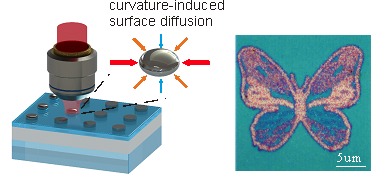Plasmonic color printing has several advantages over traditional color dyes printing: sub-wavelength resolution, the production of bright and non-fading colors. In general, the reflected color from metallic structures is determined by the plasmonic resonance, which is highly sensitive to the structure geometry and optical constants. Tuning the geometries and size of the plasmonic nanostructures is a means to tailoring absorption spectra in the visible frequency range.
Plasmonic color generation has aroused intense research interest for years, but most previous works rely on complex and expensive electron beam lithography (EBL) or focused ion beam (FIB). Anders Kristensen et. al reported using nanosecond pulses to induce the photothermal reshaping of Al nanodiscs to realize color printing. However, this method dependent on particle ablations due to high pulse energy above ablation threshold leads to generated nanostructures with less controllable morphologies.
A novel laser printing method introduced by Mr. Yudong Lu from the research group led by Prof. Xiangping Li and Mingsi Zhang of Jinan University published in Chinese Optics Letters, Volume 19, Issue 5, 2021 (Y. Lu, et al., Laser printing based on curvature-driven shape transition of aluminum nanodiscs) is based on curvature-driven shape transition below the ablation threshold. Al is chosen as the plasmonic material because it supports surface plasmon resonances (SPRs) from visible light to ultraviolet light. The Al-SiO2-Ag three-layer structure forms a Fabry-Perot resonator to enhance absorption of the incident laser energy. Curvature-driven surface diffusion model is adopted to study the mechanism of morphologic evolution of Al nanodisc, which is consequently reshaped below the melting threshold by using femtosecond multi-pulses. The reshaped nanodisc geometries as well as the printed colors rely on the power of tightly focused laser.
Prof. Xiangping Li believes that this method opens new perspecitves towards full-visible high-fidelity color prints in a highly-efficient and facile laser writing fashion. This work proposes an easy, cheap and low energy cost method to print high-density color information, which foresees promising applications in data storage, color prints and information security.

schematic diagram of laser induce shape transition of aluminum nanodiscs and experimental result diagram


